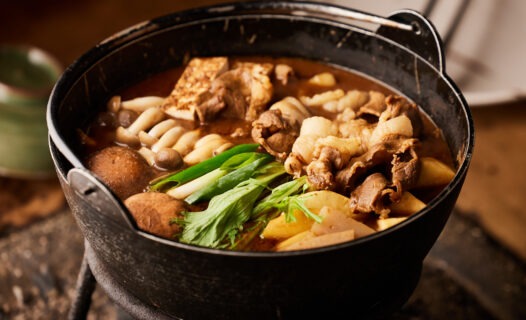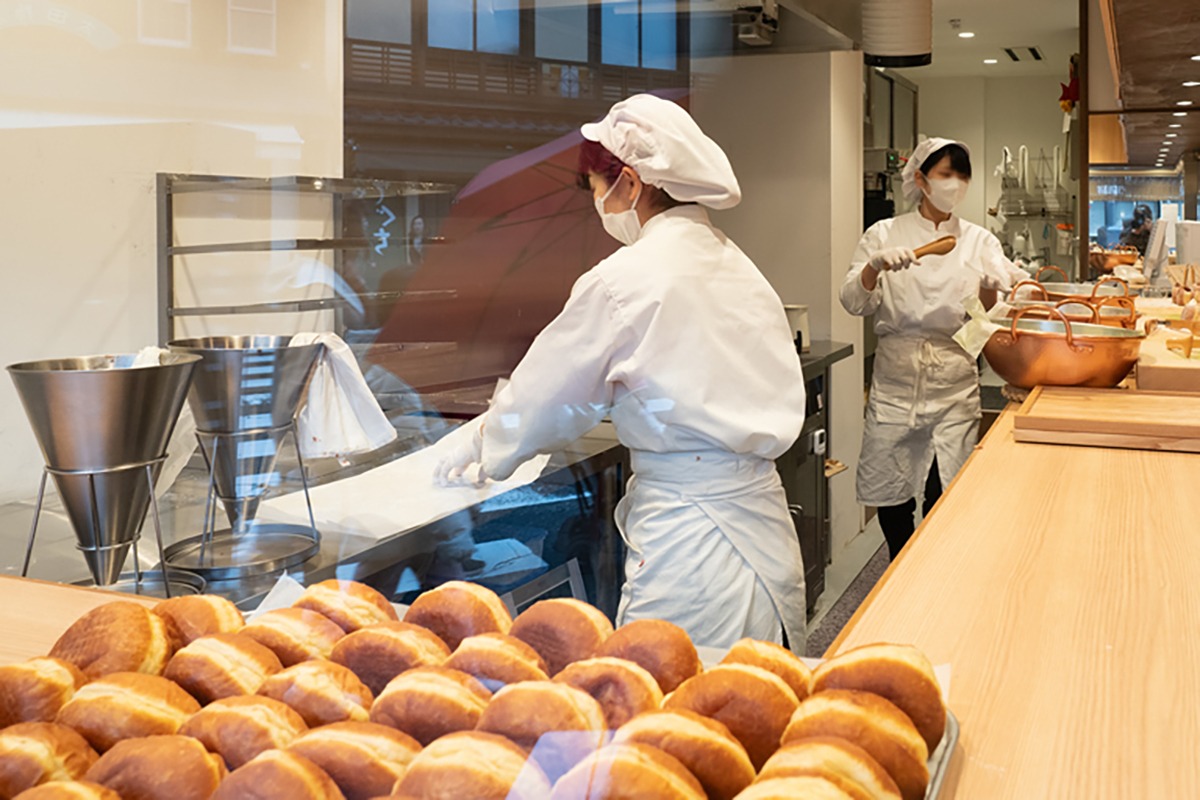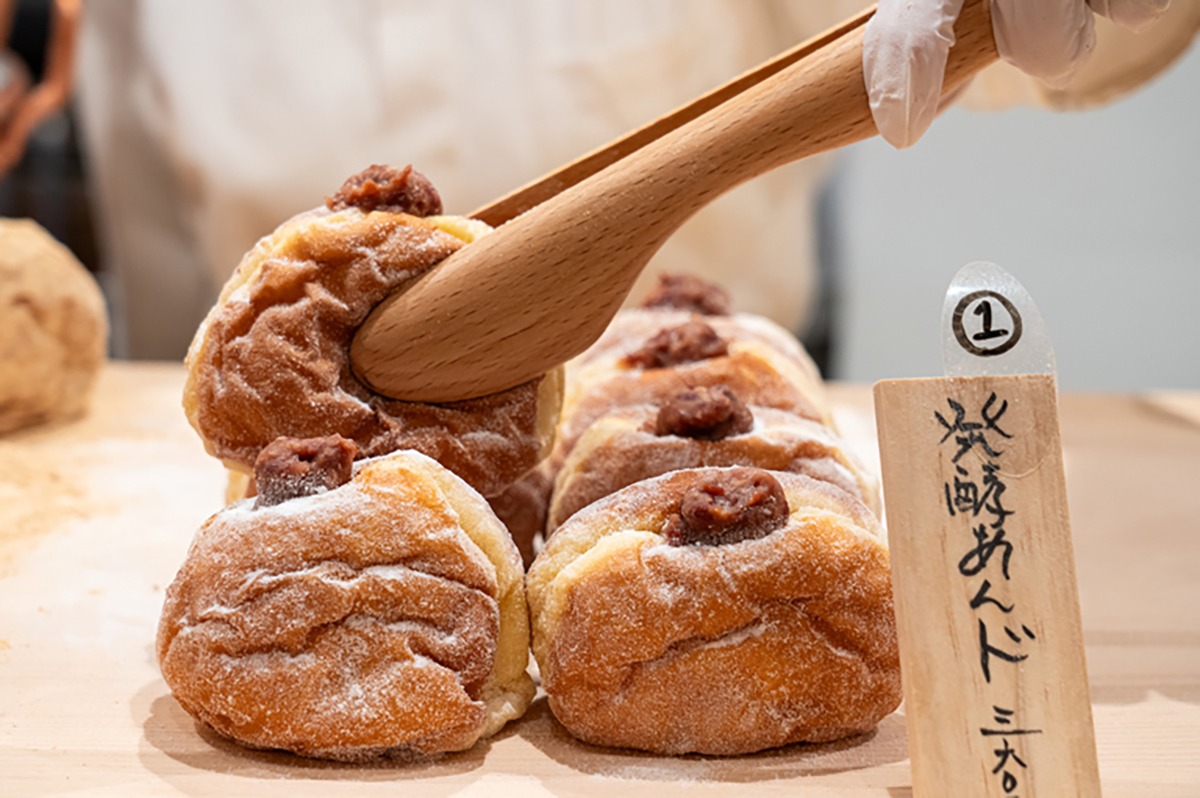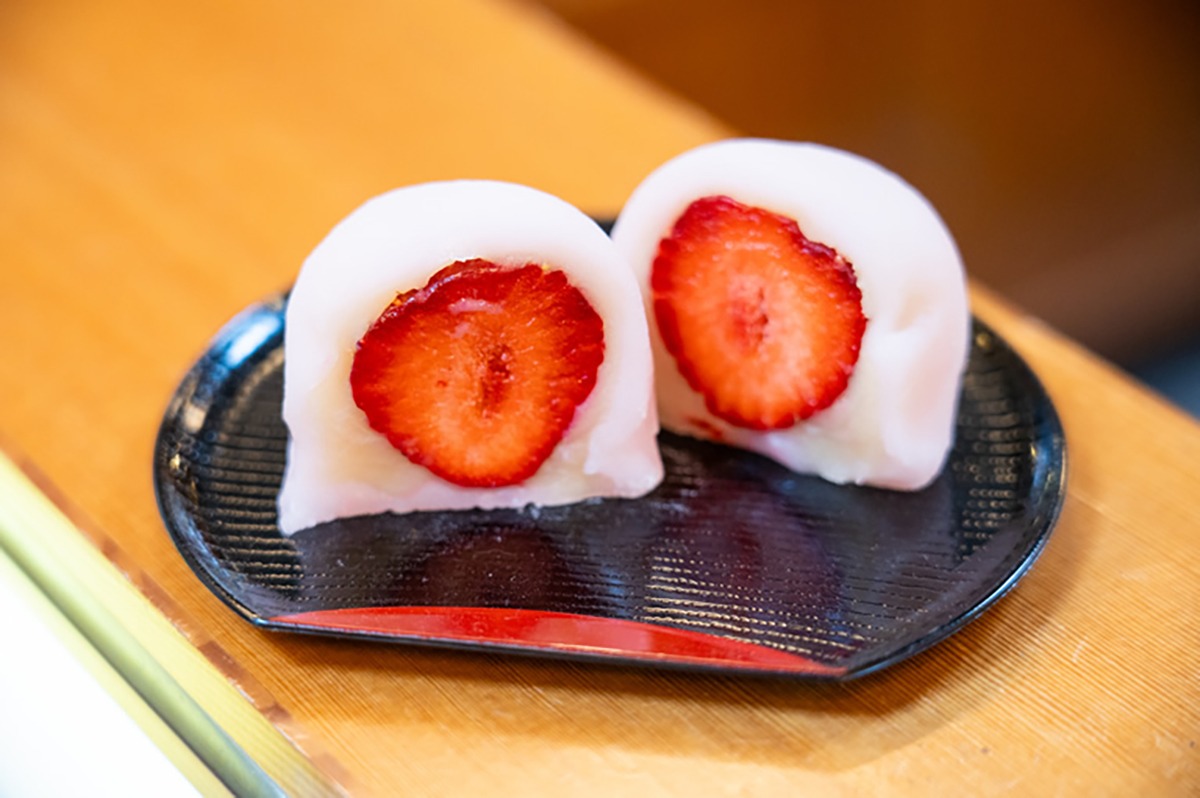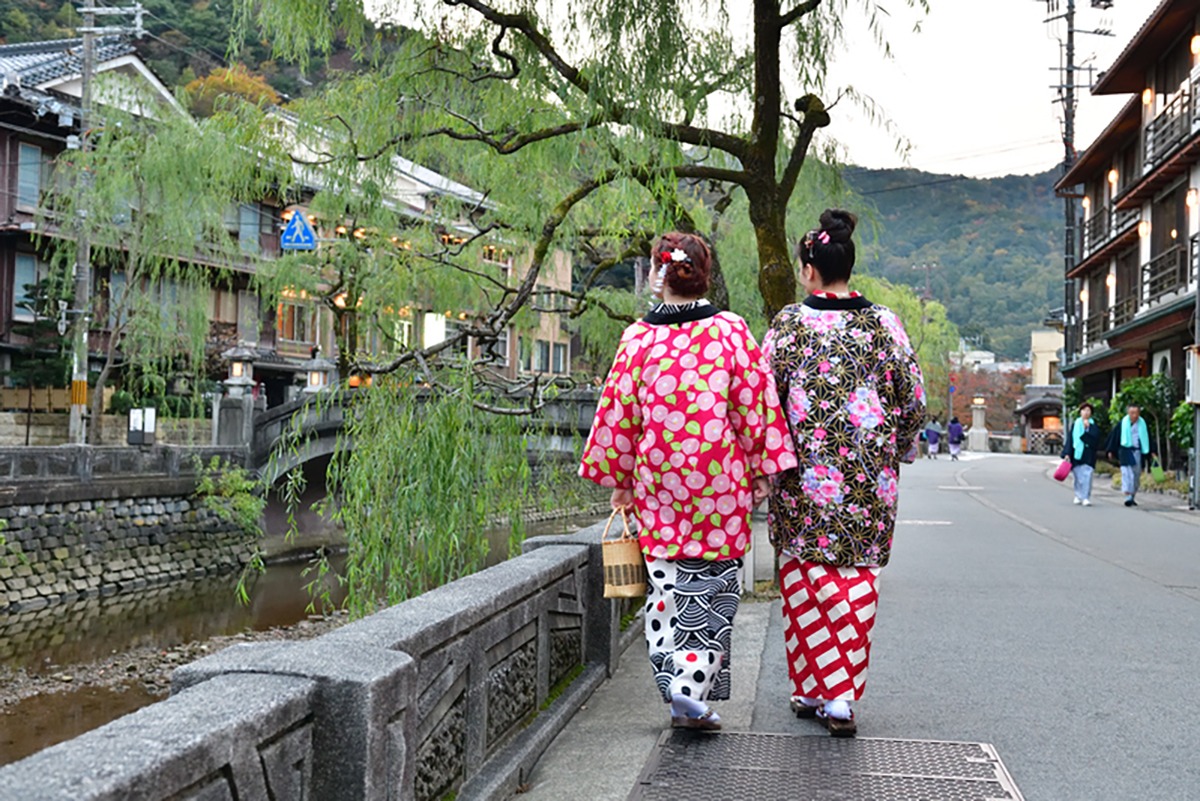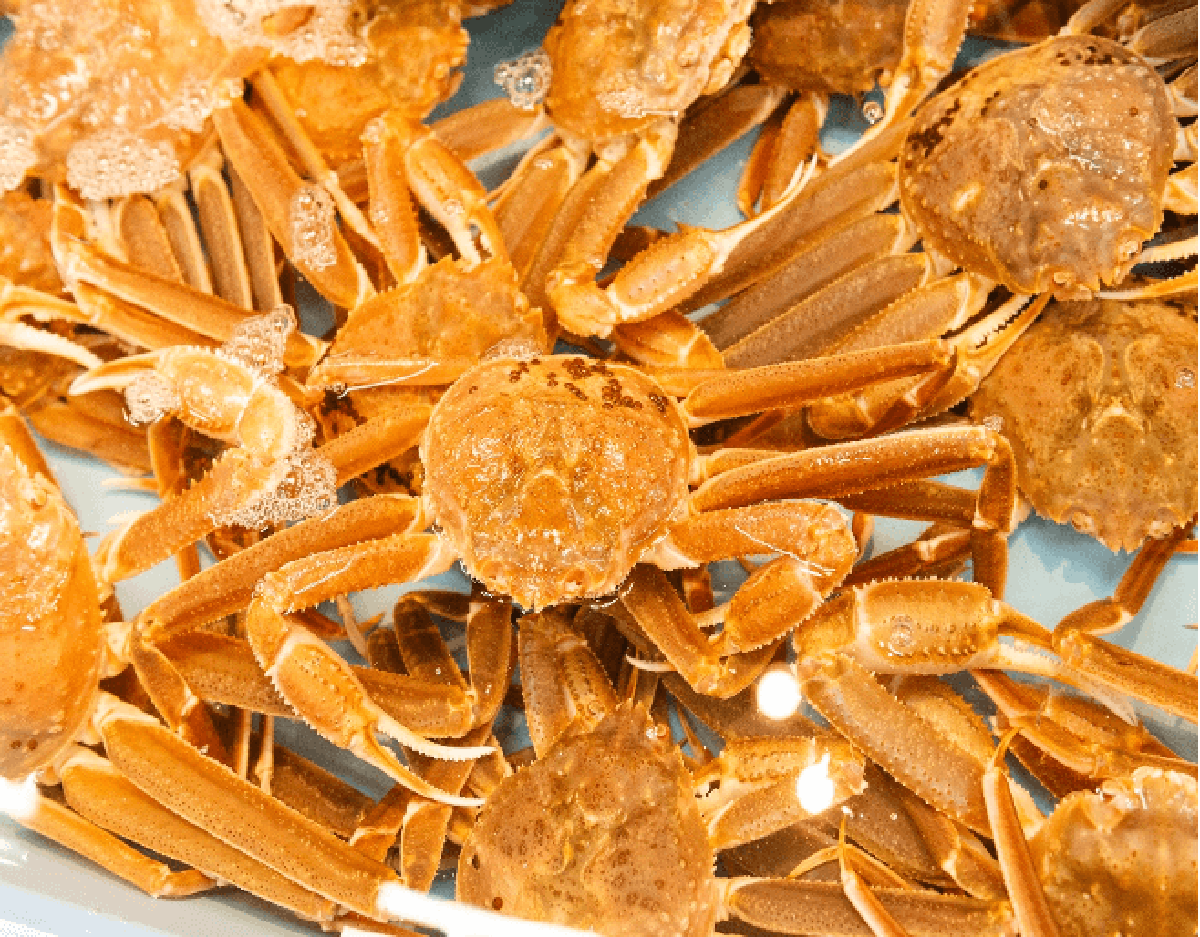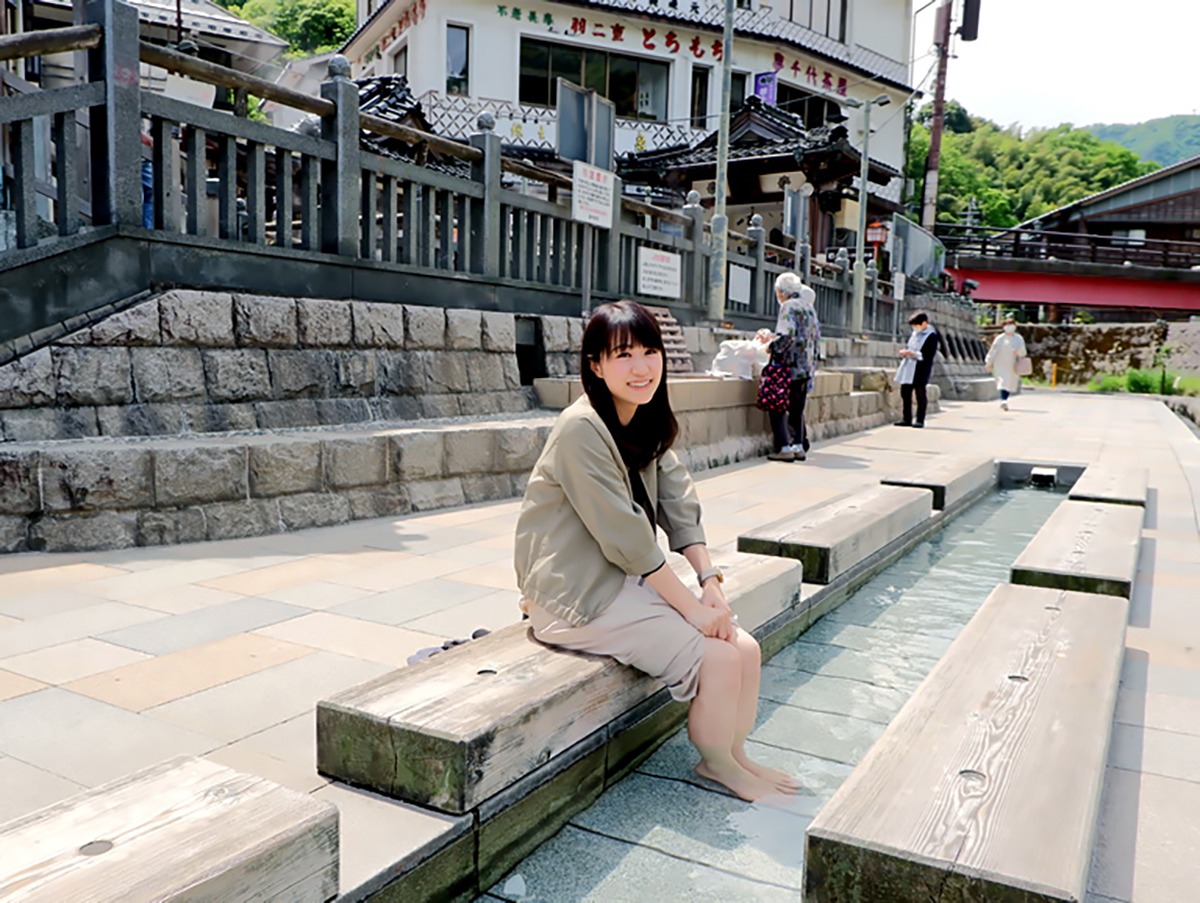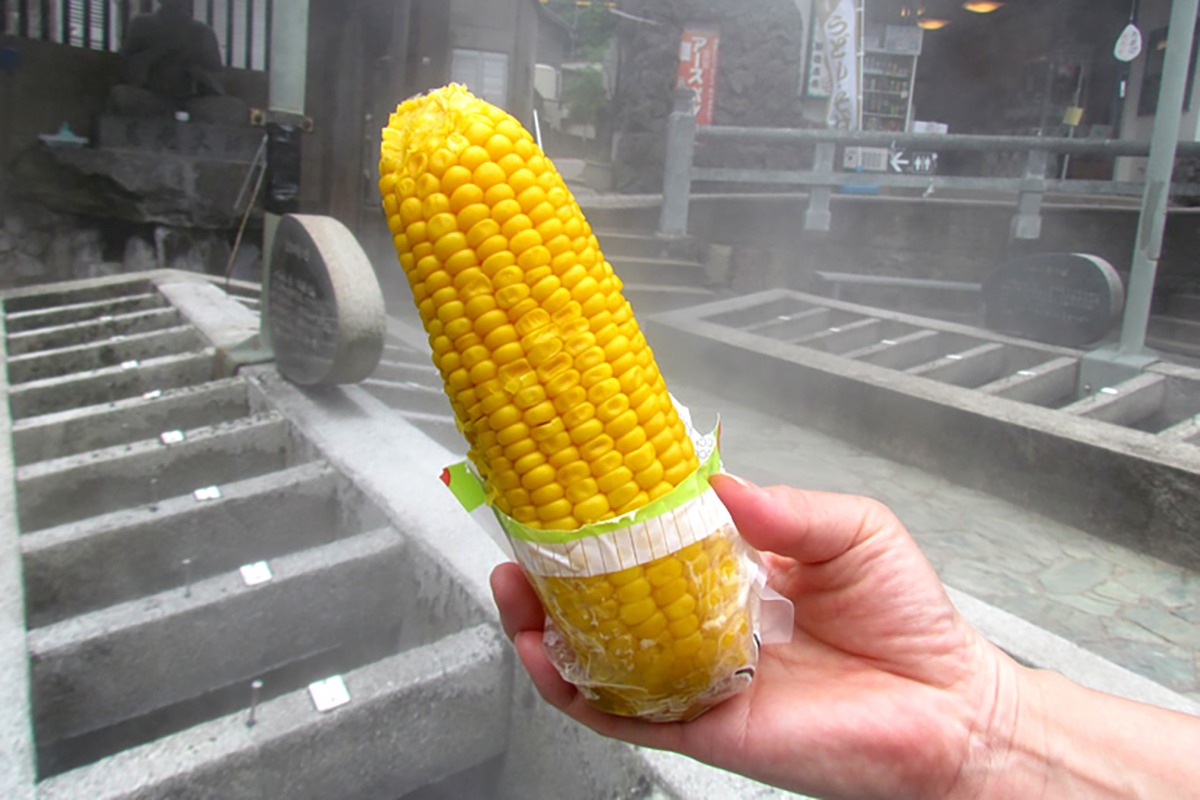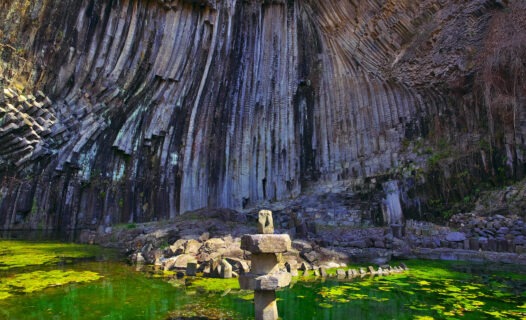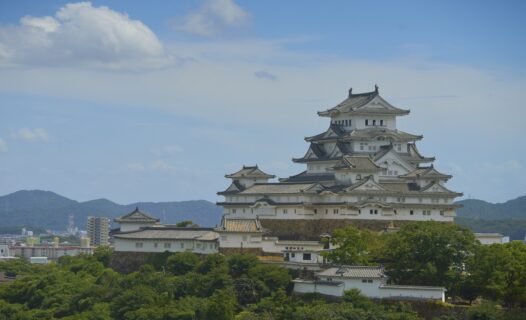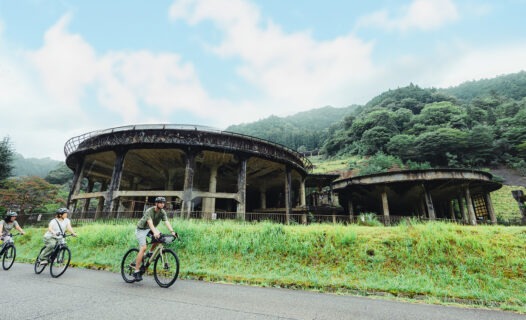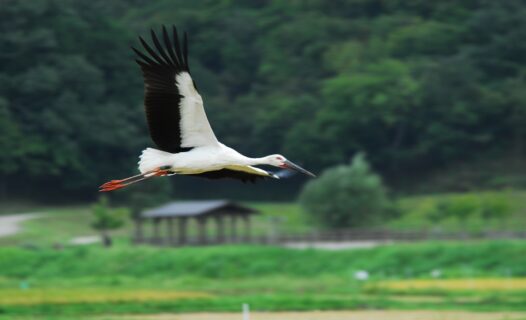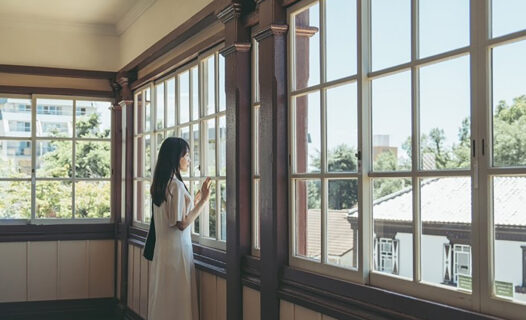Only about 2 hours and 20 minutes by JR Limited Express from Kyoto—no transfers required—lies the easily accessible hot spring resort of Kinosaki Onsen. Alongside Kinosaki, Yumura Onsen is considered one of the two major onsen destinations in the Tajima area. Surrounded by stunning natural landscapes, the region is blessed with fresh seafood from the Sea of Japan and mountain delicacies nurtured by beautiful forests and pristine waters.
Getting about in the Tajima area, home to Kinosaki Onsen and Yumura Onsen, is most convenient by bus.
BOOK YOUR HOT SPRINGS TOUR HERE
First Stop at Kinosaki Onsen: Indulge Your Sweet Tooth!
Exploring the sweets around Kinosaki Onsen is an absolute must, especially when combined with traditional soto-yu meguri (public bath hopping).
There are a total six varieties of “Hakko Ando” (fermented red bean doughnuts), from simple to creative options, all priced at 360 yen (incl. tax) each.
Kinosaki Onsen Station is surrounded by numerous sweet shops, perfect for anyone who loves sampling treats on the move. Why not start at Hakko Anka Ukawa, a stone’s throw from the station, just across the street. Ukawa specializes in donuts made with fermented anko (sweet red bean paste) that contains no added sugar, created by combining red beans and koji rice culture for a rich natural sweetness. They attract long lines of eager customers daily, but the wait for their freshly fried donuts is worth every second!
Hakko Anka Ukawa
Address: 95 Yushima, Kinosaki-cho, Toyooka, Hyogo Prefecture, Japan
Tel.: 0796-20-7097
Hours: 10:00–17:00 (closes when sold out)
Closed: Wednesdays
The “Tokusen Strawberry Daifuku” (380 yen, tax included) is available exclusively from late November to around May.
For your next treat, head over to Minatoya, a traditional Japanese confectionery shop with roots dating back to the Edo period. Inside, you’ll find a wide selection of famous sweets, but the star attraction is the “Tokusen Strawberry Daifuku,” a combination of soft mochi and sweet, juicy strawberries sure to bring a smile to anyone’s face. With your sweet tooth now satisfied, the natural hot springs beckon.
Minatoya
Address: 416 Yushima, Kinosaki-cho, Toyooka, Hyogo Prefecture, Japan
Tel.: 0796-32-2014
Hours: 8:30–17:30, 20:00–22:00 PM
Escape the Everyday with Kinosaki Onsen’s Soto-yu Meguri
A straight walk from the station lies the Otani River and its picturesque taiko-bashi, or stone arch bridges.
The charming Otani River, lined with willow trees, has long found a place in the hearts of literary figures and other past greats.
Kinosaki Onsen boasts a history spanning some 1,300 years, with legends claiming it was first started when a stork healed its injured leg in the hot springs. Today, it consistently ranks among Japan’s most popular onsen destinations.
What sets Kinosaki apart is its soto-yu meguri, a unique activity where visitors can tour six different public baths, each with its own distinctive character, throughout the town. Walking along the town’s small streets lined with symbolically swaying willow trees, and dressed in your traditional Japanese yukata, each bath you visit draws you deeper into a tranquility worlds apart from the troubles of everyday life.

Kinosaki Onsen is designed around the concept of welcoming all guests as if the entire town were one large ryokan (traditional inn). The station serves as the entrance, with the six distinct public baths acting as communal bathhouses for the entire town. In contrast to the smaller, intimate uchi-yu (indoor baths) found within each ryokan, the public soto-yu are meant to be enjoyed as part of a leisurely circuit. Though all close by, each bathhouse offers a completely different atmosphere, history, architecture, and water temperature. Soak in the unique charm of each bathhouse, a rare luxury to enjoy in your own time. Unusually for an onsen town, Kinosaki welcomes those with tattoos, allowing everyone to enjoy the baths freely.
The Sato-no-Yu bathhouse is currently closed for long-term renovations, leaving six bathhouses available for soto-yu meguri.
Kinosaki Onsen Tourism Association
Tel.: 0796-32-3663 (reception hours: 9:00–17:00)
Head to the Harbor and Dine on Fresh Seafood
Marukai Watanabe Fishery features a seafood market with direct sales, along with souvenir shops and restaurants.
The following day, set out to have your fill of the bountiful gifts of the sea. About an hour from Kinosaki Onsen by train or car, you’ll find Marukai Watanabe Fishery at Hamasaka Fishing Port on the Sea of Japan. The fish market bustles with energy as lively auctioneers call out bids amid fresh seafood on full display. Each season brings a new variety of seafood to enjoy: firefly squid in spring, white squid in summer, red shrimp in autumn, and Matsuba crab in winter. The Matsuba crab in particular is renowned worldwide, and visitors travel from all corners of the globe for a taste of the premium delicacy.
Marukai Watanabe Fishery
Address: 853 Ashiya, Shinonsen-cho, Mikata-gun, Hyogo Prefecture
Tel.: 0796-82-5011
Hours: 8:00-16:30
Closed irregularly
Immerse Yourself in Yugaki Culture at Yumura Onsen
Yumura Onsen, discovered around 1,200 years ago, has two ashiyu (footbaths) located in a well-maintained community square.
Upon arriving at Yumura Onsen, take a moment to give your feet a rest in the town’s ashiyu (footbaths). The waters of Yumura Onsen are known as “beauty baths,” said to remove dullness from the skin and leave it refreshed and moisturized, such that some visitors even take this special water home in spray bottles. A quite unique characteristic of Yumura Onsen’s water is that it’s also drinkable. Near the footbaths, drip coffee packs are available for purchase, a delightful way to enjoy a leisurely coffee while your feet get some well-deserved pampering.
Nearby shops offer fresh vegetables, along with a set of eggs and bread to make boiled egg sandwiches, yugaki-style.
The water from the main hot spring, named arayu (“rough hot water”), gushes out at temperatures as high as 98℃, with a flow rate of 470 liters per minute. At the central Arayu hot spring, both locals and visitors alike can participate in the local yugaki culture, where ingredients like eggs, vegetables, and beans are boiled in the mineral-rich hot spring water, ensuring that the food turns out moist and flavorful. Corn cobs and sweet potatoes can be found for sale at nearby shops.
Yamazaki Shop Kadomise
Address: 1233-1 Yu, Shinonsen-cho, Mikata-gun, Hyogo Prefecture, Japan
Tel.: 0796-92-0062
Hours: 7:30–19:30 (Mon–Fri)
7:30–20:00 (Sat)
7:30–19:00 (Sun)
*Operating hours may vary; updates are posted on its official Instagram and X.
Another popular service in Yumura Onsen is the onsen senpatsu, where your hair is washed with onsen water while receiving a soothing scalp massage. The natural hot spring water helps to remove dirt from the pores, softening the scalp and improving blood circulation—all made possible by Yumura Onsen’s abundant flow of hot spring water, which has 63 separate sources and a total flow of 2,300 liters per minute.
Onsen senpatsu hair washing is available at five hair salons and four barbershops with banners indicating the service, typically costing around 1,000 yen.
Yumura Onsen Tourism Association
Address: 98 Yu, Shinonsen-cho, Mikata-gun, Hyogo Prefecture, Japan
Tel.: 0796-92-2000
End Your Journey with Health-Boosting Tochimochi Sweets
Bring your trip to a satisfying end with tochimochi, a traditional confection that has been enjoyed in parts of the San’in region for centuries. This horse-chestnut sweet is made from the nuts of the tochi tree, which grows in Tajima’s primeval forests. The horse chestnuts undergo a month-long process to neutralize some their bitterness, preserving their unique flavor with just a hint of bitter tang. Tochi horse chestnuts have long been regarded as a remedy for longevity and are known for their beauty and health benefits, making tochimochi a favorite souvenir and a delightful treat to go with tea.
Sohonke Tochisen
Address: 1250 Yu, Shinonsen-cho, Mikata-gun, Hyogo Prefecture, Japan
Tel.: 0796-92-0331
From Yumura Onsen, you can take a bus to Hamasaka Fishing Port before traveling along the Sea of Japan by car and bus to Tottori Sand Dunes Conan Airport, a trip of about two and a half hours in total. As you take in the picturesque scenery and wrap up your journey in the Tajima area, you might find yourself drawn to Tottori, a destination that captivates visitors from around the world with its famous sand dunes, the neighboring Sea of Japan, and its status as a mecca for anime fans.
Access to Hyogo Prefecture
Hyogo Prefecture is accessible by Shinkansen (JR) from Tokyo, Osaka, and Kyoto. Travel by air to Kansai International Airport is also convenient, with limousine bus services to Osaka available from the airport.
Kinosaki Onsen, featured in this article, can be reached in about 2 hours and 20 minutes from Kyoto by JR Limited Express or about 3 hours and 40 minutes by highway bus, both without transfers.
